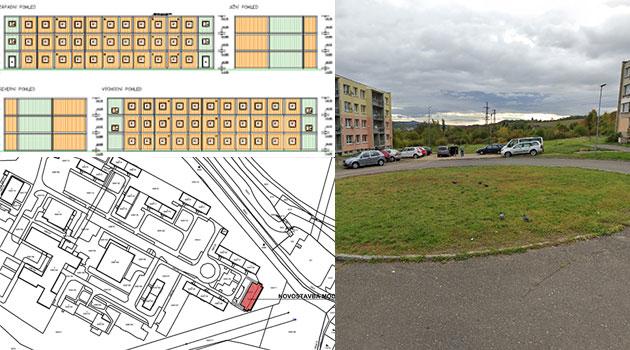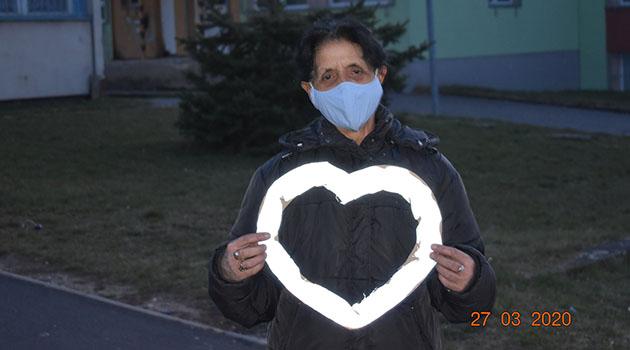Czech town's project to install "container housing" on mostly-Romani housing estate published online by opposition local assembly member

The project documentation for the building of residential housing out of repurposed shipping containers is now public thanks to Adam Komenda, an opposition member of the local assembly in Most, Czech Republic. He obtained the documents after a complex, roundabout route involving filing a request under Act No. 106 on freedom of information and successfully appealing to the Regional Authority.
Komenda has now published the documentation on the Internet. The city council intends to build install the modular housing next year and has allocated CZK 25 million [EUR 950 000] to do so in its draft budget.
A petition being signed by the housing estate residents rejects the project. In a press release sent to news server Romea.cz, Komenda says that “Experts are currently analyzing the project – for example, architects and city planners. Their view of the project should be known in a few weeks.”
The city council wants to present a visualization of this new type of housing as soon as possible to the residents of the Chanov housing estate, but the timing of that presentation is not yet known because of the pandemic. “We are addressing how to do the presentation at Chanov, given what is happening around the coronavirus. I believe a public discussion will be possible in the new year. In any event, we will do that ahead of implementing the project or announcing the tender,” Deputy Mayor Marek Hrvol told the local daily newspaper Mostecký deník.
Komenda wants the standpoints of the independent experts he has contacted to be heard at that meeting. “As an assembly member in Most, I will endeavor to make it possible for the authors of standpoints on the project to be able to present them during the planned presentation of the project for building container housing that the City of Most plans to undertake right at the Chanov housing estate for its residents. I am convinced that in addition to information about the container project from the city, Chanov residents have the right to learn about independent standpoints on this project. There could then be a discussion of the container project and the experts’ standpoints on it. That discussion could be attended by local residents, representatives of the city leadership, experts, and all of the Most city assembly members, whom the city leadership has already promised to invite. I believe that discussion and its eventual continuation during the next session of the assembly will take place in an objective spirit in which both sides will mutually respect the arguments submitted and attempt to weigh all of the pros and cons,” Komenda told Romea.cz.
The assembly member also described how complicated it was for him to acquire a digital version of the documentation for the entire project and the obstructions imposed by the leadership of the city of Most. “My request, as per the law on freedom of information, to be provided with the project in digital form, sent to my e-mail address, was not initially met. I was told I could come to City Hall to look at the project. Since I wanted to consult the project with experts, I was not satisfied with that, and I appealed to the Regional Authority. In the end the Regional Authority instructed City Hall to accede to my request,” Komenda said.
“After that a problem arose when City Hall informed me that because it would be too administratively burdensome for them, they could not send me the project by e-mail because the files were too big, and for that reason they changed the format of delivering this information, once again asking that I make an appointment to come to City Hall where they would make it possible for me to look at the project and photograph it. I was not satisfied with that and I asked why they couldn’t send me the project through an online dropbox or whether they couldn’t upload the project to a flashdisk. However that solution also, they said, was impossible because of a very broad range of technical complications and limitations. Eventually, however, we manage to find a compromise solution and the project was uploaded to my laptop,” Komenda said.
According to the project documentation, the container housing should be built at the Chanov housing estate behind the roundabout there. A three-story block made out of repurposed shipping containers would house a total of 18 apartment units.
Chanov residents have initiated a second petition, which exists in an online version, against building container housing on the estate. It has been signed by the former Human Rights Minister Džamila Stehlíková; the author and priest Ladislav Heryán; instructor at the Faculty of Arts and Design at the University of Jan Evangelista Purkyně in Ústí nad Labem, Martin Kolář; human rights activist Jozef Miker; a teacher at the Litvínov-Janov Primary School and assembly menber of the town of Lom, Marian Dancso; the artist and initiator of the Romafuturismo project for a library of Romani literature, now the Josef Serinek library, Ladislava Gažiová; Ústecký Regional Assembly member Karel Karika; the first local assembly member from the Romani community in Chomutov, David Ištok; journalist Tereza Cajthamlová; and local assembly member for the town of Příbram and Central Bohemian Region assembly member Antonín Schejbal.
According to the Romani activist and representative of the petition committee, Ján Chromý of Chanov, the hard copy of the petition has been signed by more than 400 people so far. Currently sharing the hard copy of the petition has been suspended because of the pandemic, but the collection of signatures on it should continue until the close of the year once that becomes possible.
The plan to build containers at Chanov was previously condemned by the then-Public Defender of Rights Anna Šabatová. “I have come to the conclusion that building modular housing at the Chanov housing estate would result in solidifying the segregation of the Romani residents of Chanov and is an example of discrimination in the area of housing, on the basis of ethnic origin,” she wrote in a report based on a local investigation.
The Agency for Social Inclusion, which is part of the Czech Regional Development Ministery, also stopped working with the City of Most because of the planned construction of container housing at Chanov. The housing estate is located about two kilometers away from Most proper on a hill to the west, above a settlement called Chanov that is part of the municipality of Obrnice.
The housing estate was built in 1978, when a primary school and 13 apartment blocks with roughly 400 units were built there over time. The Old Town of Most was demolished in order to mine brown coal deposits beneath it, and its Romani residents were then gradually relocated to the new housing estate.
